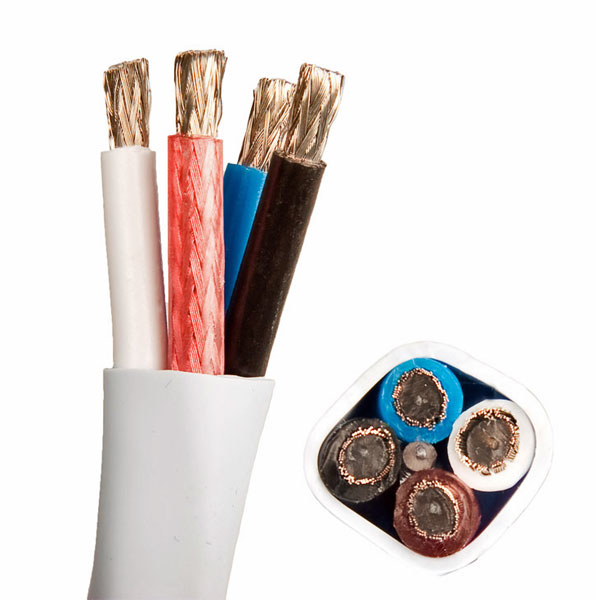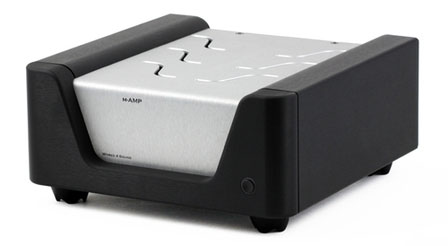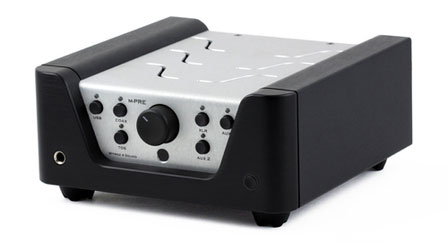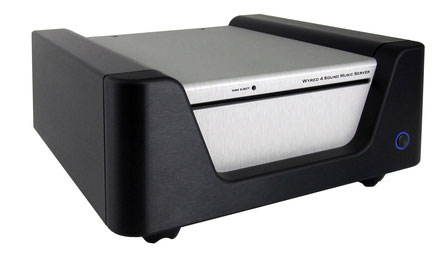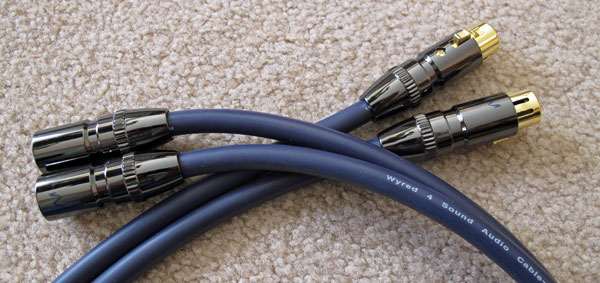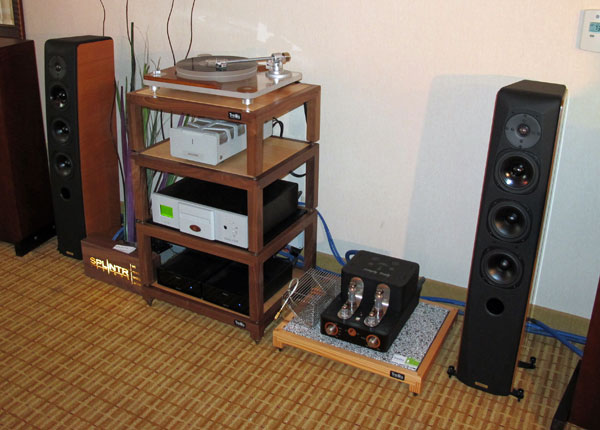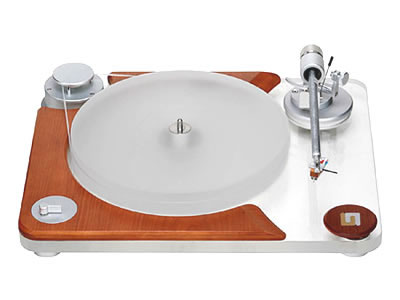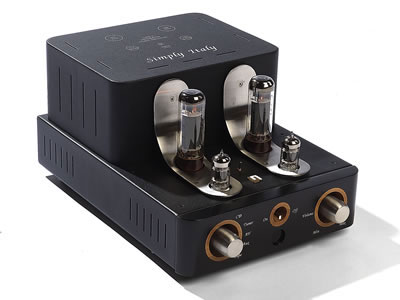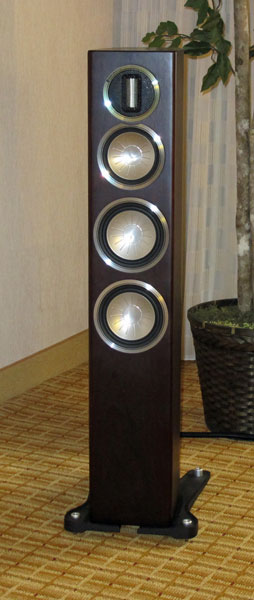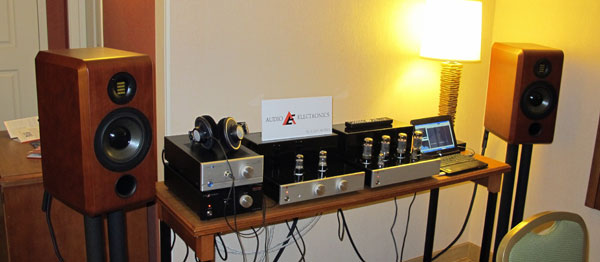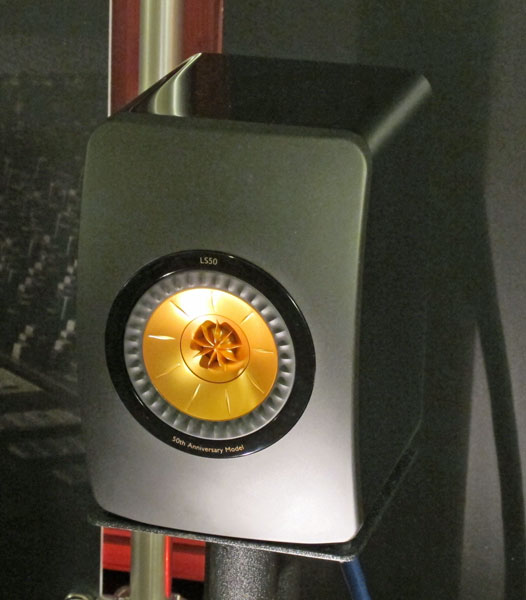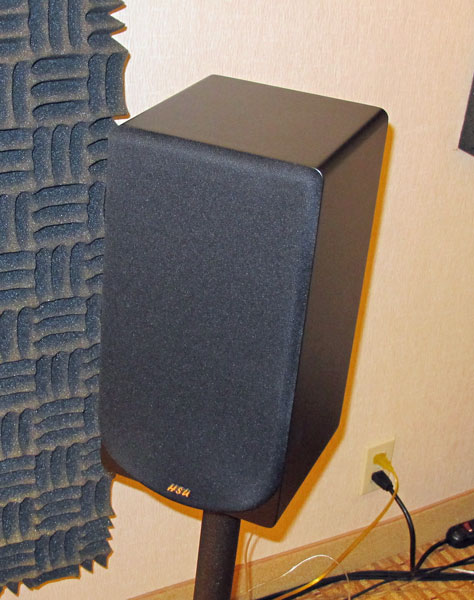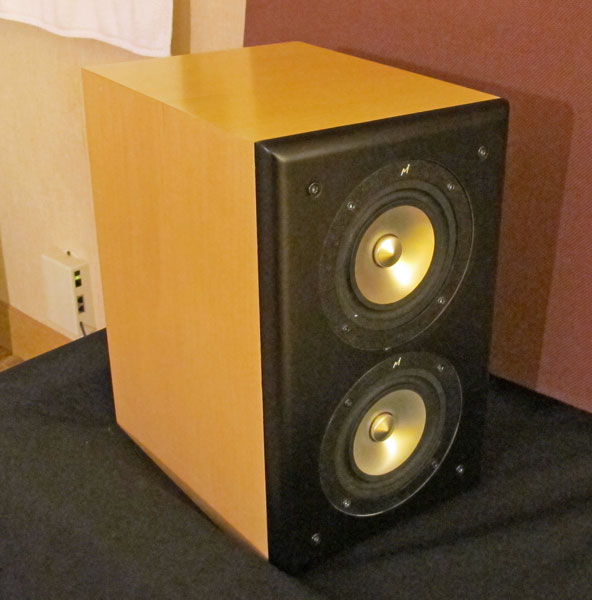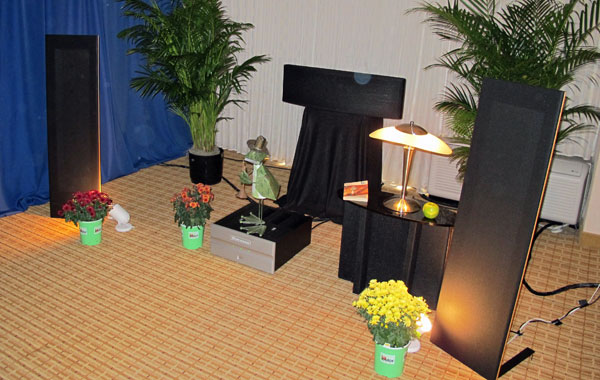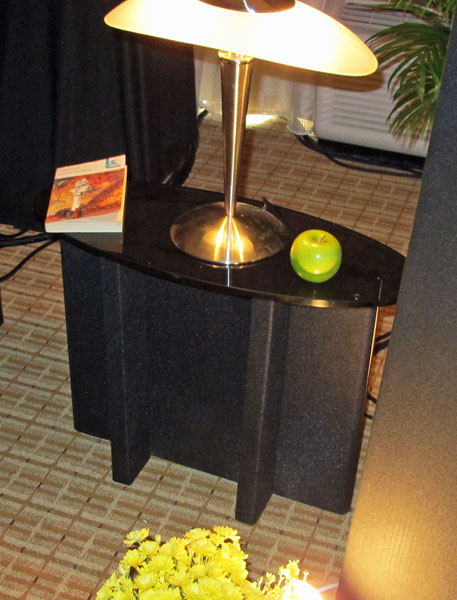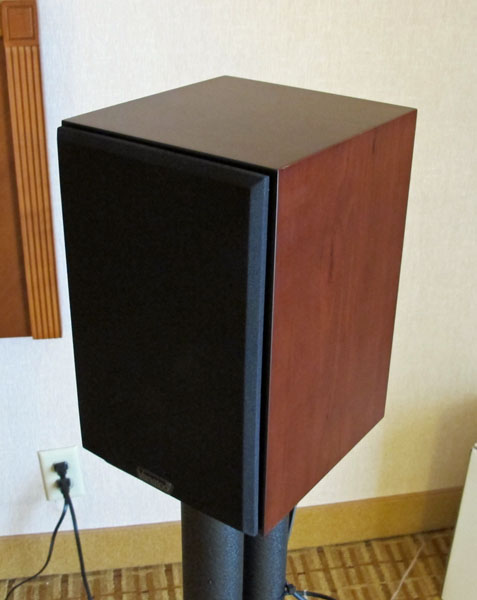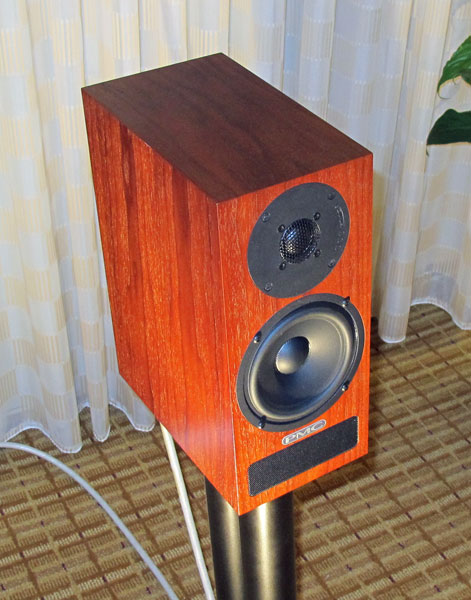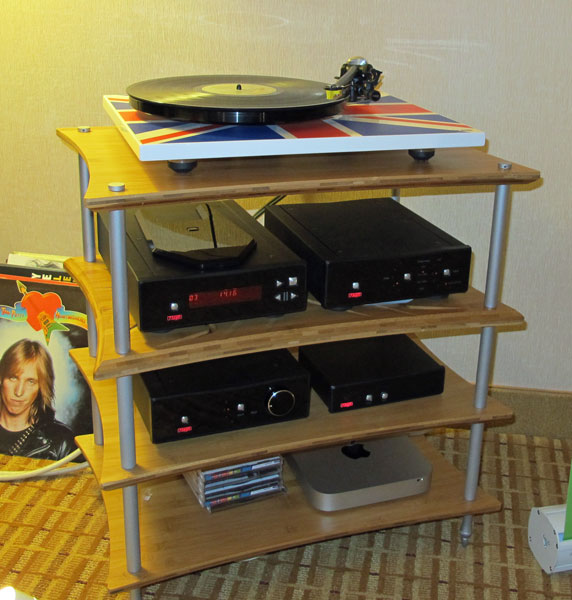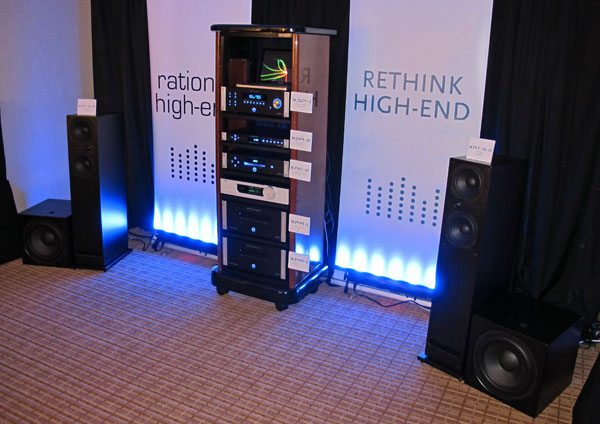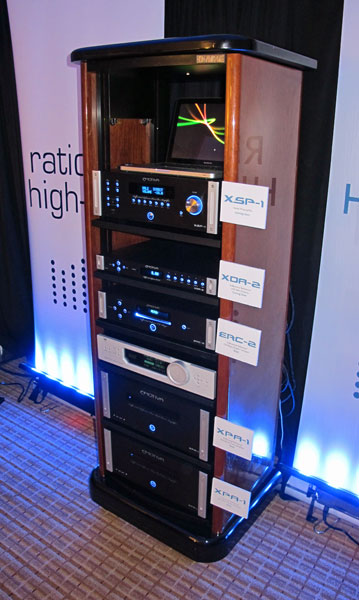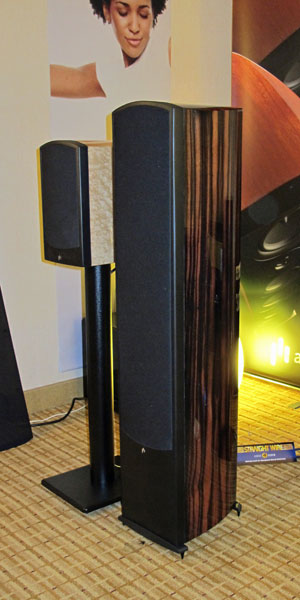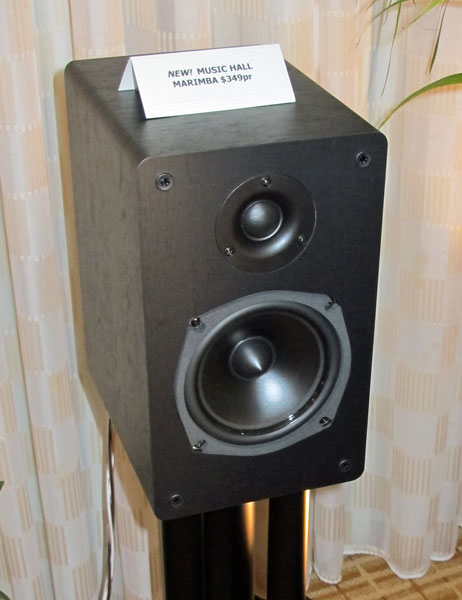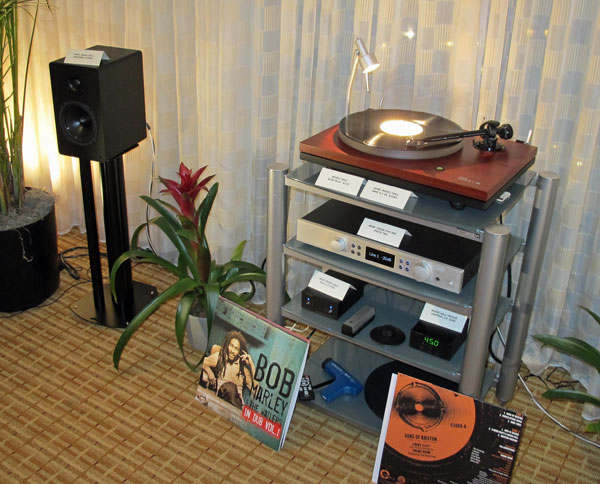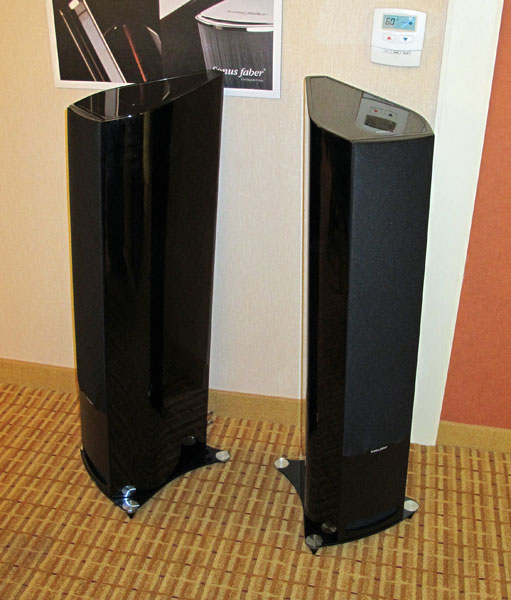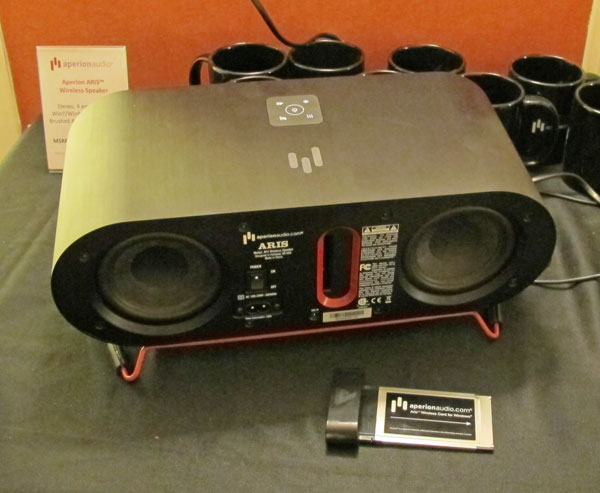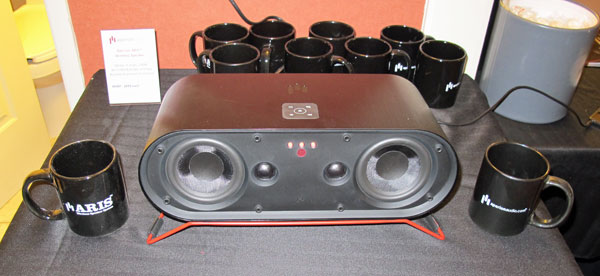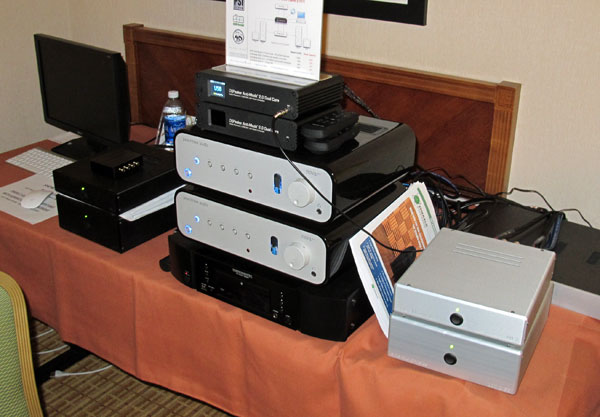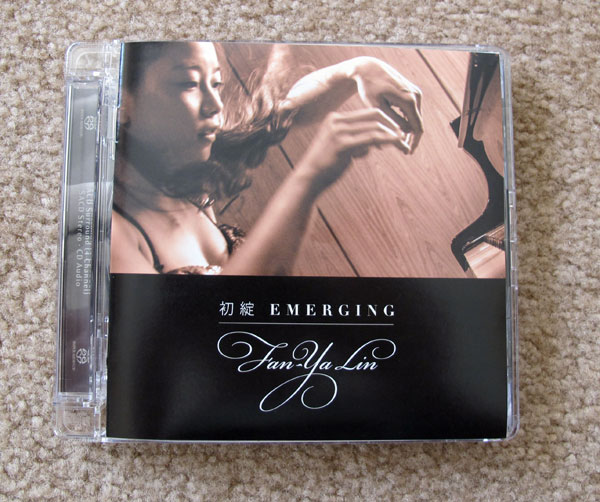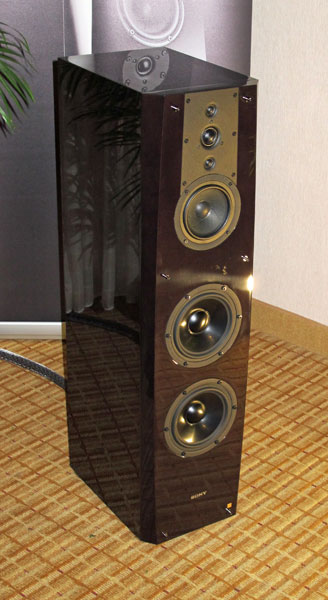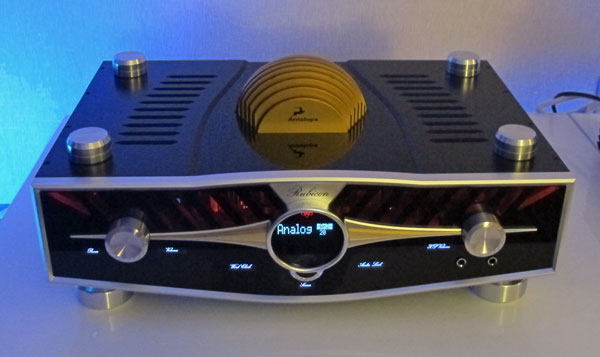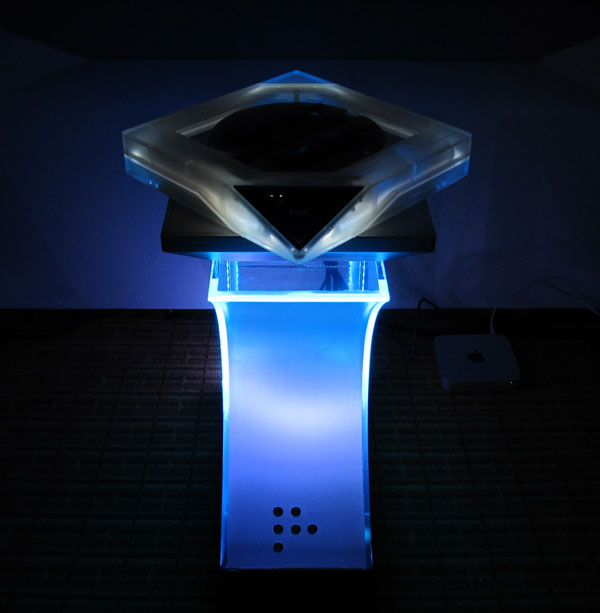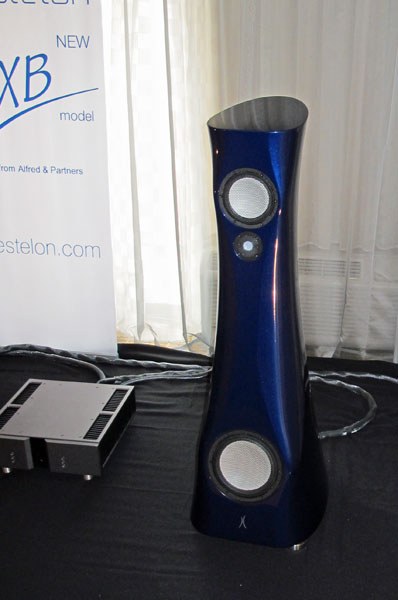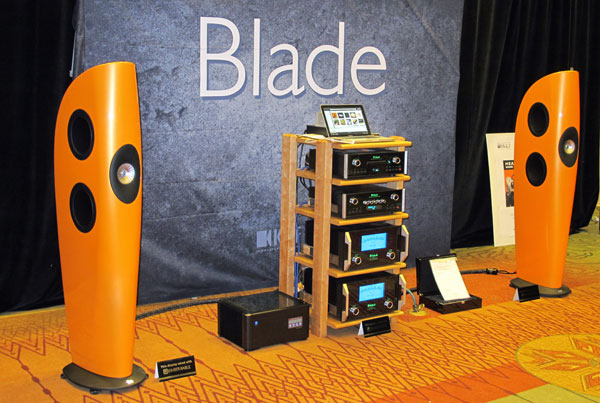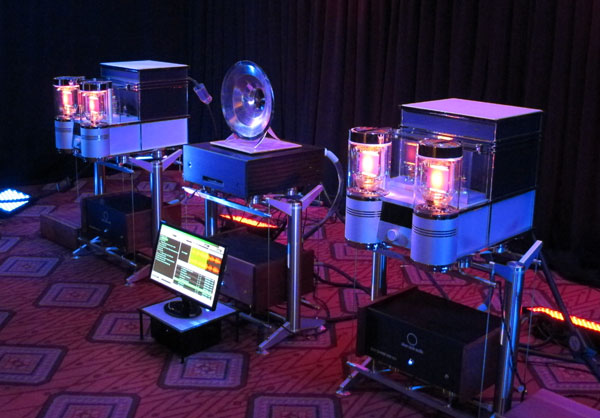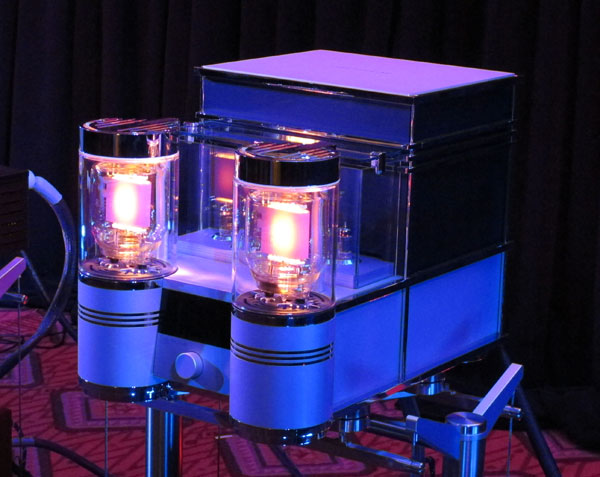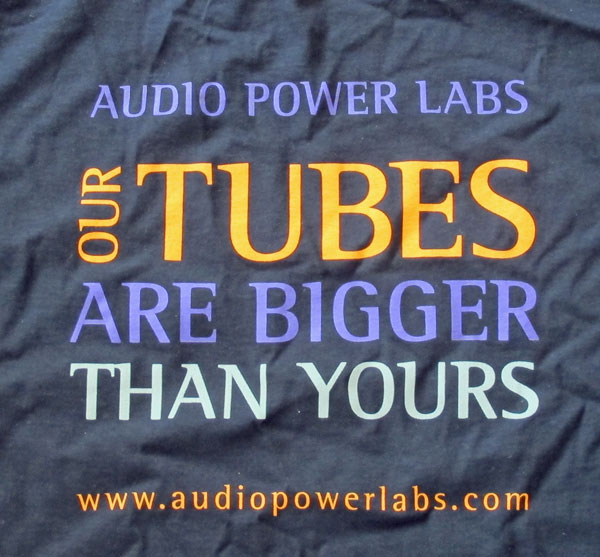|
You are reading the older HTML site
Positive Feedback ISSUE 64
Rocky Mountain Audio Fest 2012
I wasn't able to attend RMAF in 2011 so it was really great to be in Denver in October once again. The show is the only time I get to see a lot of the people I have gotten to know over the past few years. Listening to the equipment is a lot more enjoyable when you are doing it with people with whom you have become friends. The interesting thing about this year's show, for me, was how much vinyl was being played and how many rooms were using it as their primary source. I would guess easily half the rooms were turntable equipped. Most of the other half were using computer systems to demo their equipment and a small minority, maybe around 5%, were using CDs only. This is really quite a shift from 2010. My focus, as usual, was on affordable equipment of which there was no shortage. Like most visitors, though, I couldn't resist the lure of hearing some of the exotic offerings. I think our audio hobby needs the exotica and would be far poorer without them. At the same time, I found some of the ridiculously expensive equipment kind of uninteresting to listen to. Knowing that I'll never be able to afford it, and knowing that the person who can afford it will probably be buying it only for its status value not its sound, does take some of the fun out of it. And, if you don't have a room the size of a ballroom to put it in, its performance capabilities will never be appreciated anyway. It's also possible that I'm just getting old and bitter. In more or less the order in which I wandered through the exhibitor's rooms, here is my entirely selective report on RMAF 2012. The Affordable Sjofn HiFi
Sjofn HiFi brought a couple of new Supra Cables to the show. Supra has a new v1.4 HDMI cable. It retails for $90 for a one meter length and is primarily intended for computer audio although it would certainly be an upgrade for most home theaters. I got one cable at the show and will be getting two more to try in my home theater. I expect they will be a big improvement. I am using, well, junk at the present. It's only television.
The last cable Tommy Jenving of Supra designed before his untimely death in November of 2011 was the Quadrax speaker cable. This cable has four, 4 by 2mm rectangular wires oriented in a spiral rotation within Supra's usual light blue Polypropylene (PP) external jacket. The cable is designed to be used as a bi-wired pair but it will also work fine as a heavy duty stereo cable (11 gauge). The performance is claimed to be just slightly less than that of Supra's Sword cable but the cost is only $32 per meter in bulk. The performance to cost ratio is potentially ridiculous. I will be getting a pair for review soon. Quadrax is also available factory-terminated. A three meter pair is $475, only a bit over a third of the cost of a pair of equivalent Sword cables.
(The Clue) loudspeaker ($1500 per pair) wasn't new at RMAF but the way it was being used was. Shades of the original Advent, Sjofn was using a stacked pair of them! While stacking them has minimal effect on frequency response—the bass goes only a dB or so lower—the resulting performance is remarkable. Using the new Quadrax speaker cables, a stacked pair offered nearly life-size imaging with dynamics and impact that quite literally rivaled the megabucks exotics being shown in the first floor ballrooms. I, and most visitors to the Sjofn room, were stunned by what we heard. Here was $3,000 worth of speakers offering 90+ percent of the performance of speakers starting at ten times the price. At this point, I can't set up a stacked pair properly but when the opportunity presents itself, it is definitely going to happen. The precise set up parameters are still being worked on but Sjofn should be offering information as to the best way to set up a stacked pair sometime soon. www.sjofnhifi.com Wyred4Sound
Wyred4Sound was showing their new line of mini components. These solid compact boxes continue W4S' tradition of offering extremely high value with equally high performance. Each component measures approximately 8 by 8 by 3.5 inches (WDH). While the family resemblance is still unmistakable, I think the new components have progressed a step or two cosmetically. One of the goals in designing these components was to limit the number of visible screws. Now there are only two visible on any of these components. Personally, I liked the screws. I think that they provided a very Swiss-precision look to the components.
The system in use consisted of a pair of mAMP monoblocks ($899 each). Each amp outputs 250 Watts into 8 Ohms and 470 into 4.
The mPRE preamp ($1099) includes a 24/192 DAC with USB, coax, and Toslink connections.
The MS-1 music server stores the music and can be run wirelessly ($1999). There is also a Mini Integrated amp available at $1499. The speakers in use were Paradigm Reference Signature S8s ($8999) with S12 sub-woofer ($2499). The sound was full, dynamic, and very satisfying.
I'm not sure if a lot of listeners are aware that W4S is offering balanced and unbalanced interconnects, digital, and power cables. Their C-1 interconnect line has both RCA and XLR terminated cables starting at $125 per pair. I have been listening to a pair of their C-2 balanced cables since June (pictured in the photo above). These feature PCOCC (Pure Copper by Ohno Continuous Casting) copper wiring. They sound great and, at $225 per pair, strike me as a superb bargain as well. There are also the P-1 series of power cables and W4S digital cables available. www.wyred4sound.com www.paradigm.com Unison Research
Unison Research was showing a complete system including Giro turntable ($3995 in basic form), Pure Audio Vinyl preamp ($4500), Simply Italy integrated amplifier ($2450), and Opera Grand Mezza speakers ($2795).
The Simply Italy integrated outputs only 12 Watts per channel from a pair of EL34s but drove the 89dB sensitive Mezzas with no effort at all. The system was beautiful to look at and listen to. www.unisonresearch.com The Odyssey Audio and GIK Acoustics Room
Odyssey Audio was featuring a complete system priced at $5900. This included an Odyssey Candela tube preamp ($1500), a Stratos power amp ($1400), a pair of Kismet Reference Monitors ($3500/pair), and German-made Groneberg Quattro cables to wire it all together. The Candela preamp uses a pair of easily rollable 12AU7s. The Stratos amp is rated at 150 Watts per channel. Odyssey makes everything in the US, except, obviously, the Groneberg Cables. When I first walked into the room, a visitor was playing something absolutely ear-destroying at the threshold of pain. I will say this for the Odyssey system—it never backed down. The only howling came from the recording and the Odyssey equipment never displayed any evidence of stress. On actual musical material, the Odyssey setup sounded extremely good. GIK Audio did the room treatment and I plan to check out a pair of their 242 Acoustic Panels in my living room system as soon as I can get to it. These panels measure 2 by 4 feet by 2 inches thick. The price ranges from $70 to $75 per panel, a real deal. www.odysseyaudio.com www.gikacoustics.com Denver Audio
Denver Audio was running a full Arcam system through Monitor Gold GX 200 loudspeakers.
The Arcam system consisted of a CD37 SACD/CD player ($2299), an A38 integrated amp ($2399), and a P38 power amplifier ($1599). Both the integrated and power amp produce 105 WPC into 8 Ohms and 200 WPC into 4. I listened via the CD37/A38 combination. This setup gave me the opportunity to listen to one of the Kimber IsoMike SACDs that I had purchased (see below). The Gold GX 200s ($4495/pair) produced a sound that was fast, well-focused, and musical. Truly a music-lover's system. www.arcam.co.uk www.monitoraudio.com Adam Audio and Audio Electronics
German loudspeaker manufacturer Adam Audio and Cary Audio's Audio Electronics division combined to offer a very nice affordable system in their room. Adam Audio is best known for professional monitors. I understand that the Beatles were remastered using their speakers. The system that got my attention featured the Adam Compact Classic MK3 monitor speakers ($3000) driven by an Audio Electronics Constellation Preamplifier ($1495) and Hercules Amplifier ($1895). All the listener has to add is his or her choice of source. The tubed Constellation utilizes a pair of 6SN7s for a very musical sound. The Hercules puts out 30 Watts per channel from a pair of EL34s. These components drove the 87dB efficient Classic MK3s beautifully and looked very high end as well. www.adam-audio.com www.aebycary.com Hear No Evil Audio
Hear No Evil Audio of Westminster, Colorado had a number of rooms at RMAF with a wide variety of equipment. I was drawn to the room where they were demonstrating the new KEF LS50 50th Anniversary Commemorative coaxial monitors using Parasound electronics. The KEF LS50 has gotten great reviews and even a short time spent listening proved why. This is a wonderful small speaker. At $1450 per pair, it is also very competitively priced. www.kef.com www.parasound.com Hsu Research
Hsu Research was displaying possibly the least expensive speaker system at the show. It consisted of a pair of their HB-1 MK2 satellite speakers ($149 each) with their least expensive powered subwoofer the VTF-1 MK2 ($449). This system sounded absolutely great driven by a midlevel Sony CD player and Onkyo AV receiver. Honestly, I would not have believed the quality of the sound had I not heard it for myself. Listening to a cappella voices, the center image was so solid and tangible that I thought the HC-1 MK2 center channel speaker was also in use. It wasn't. True, the cosmetics are not going to win any design awards, but if unreasonably good sound at a very reasonable price is what you are looking for, Hsu is providing it.
Of course, you can spend more if you want. Hsu has a full line of subwoofers for both stereo and AV use. www.hsuresearch.com Dupuy Acoustique
Dupuy Acoustique is a new brand to me and despite its French-sounding name is headquartered in Tappan, New York. Dupuy was showing their two entry level speakers with matching subwoofers. The larger speaker, the Bongo, (I love the name.) utilizes acoustical research originally done by Roy Allison into loudspeaker interactions with the room. The lower of the two mid-woofers is limited to a frequency range below 400Hz. Its output is designed to offset the dip in output due to the floor effect. Dupuy refers to this as their proprietary FDCN (Floor Dip Compensation Network). Listening to the Bongo, you would never suspect anything uncommon was going on. It is simply an excellent sounding speaker with great imaging. I spent some time listening to Keith Jarrett and Charlie Haden's “Jasmine” CD and loved every minute of it. The Bongo is beautifully made and weighs a ton for its size. At $3500 per pair it offers a lot of sophisticated design and a very high quality build. A dedicated 300W subwoofer is also offered; it fills in below 50Hz and costs $1500. Dupuy also offers the Kata speaker system which is smaller and less expensive than the Bongo. This system includes a pair of maple-veneered Kata monitors, stands, and dedicated subwoofer for $1800. Unfortunately, I did not have time to listen to this system. For a smaller room, it looks like it would be a great way to get listening. www.dupuyacoustique.com Magneplanar/Bryston Room
Magneplanar was showing their newly revised MMG speaker (“The lowest priced planar/ribbon speaker in the world.”) along with matching center channel and DWM bass panel. Amplification was from Bryston. The room was so busy that reservations were required. I, by dumb luck, walked up as they had one seat still open. The demo was short but impressive. The little MMGs sounded terrific. The center channel was being used as part of the system, which helped the central image. In a smaller room, this would probably be unnecessary. The MMGs are sold factory-direct and buyers have 60 days to decide it they want to keep them. If they do keep them and decide later to upgrade, a buyer can receive up to their full purchase price against the new pair. The MMGs are such a great deal that I have to think most buyers would decide to keep the MMGs for a second system rather than trade them in.
The DWM bass panel can be used with any Magneplanar speaker. I would like to have learned more about it but there was no opportunity at the show. The information on the web site is, unfortunately, very sketchy. The DWM appears to be entirely passive but there is no information as to how it is to be crossed over or integrated with any of the other speakers. I think it would be totally killer to run a pair of DWMs with Wyred4Sound mAMPs. www.magnepan.com www.bryston.com Vanatoo Transparent One Powered Speakers
The Vanatoo Transparent One is a small powered speaker, 60 WPC, that can be run wired or wireless with wireless being the intended mode. It has a built-in DAC that can accept up to 24/96 data streams.
I took a photo of the rear of the speaker as I know I cannot fully describe all of its connection possibilities. Hopefully the photo will be worth at least a few hundred words. The Vanatoo is nicely finished in either black or natural cherry. It has a passive radiator on the rear and the mid-woofer is impressively heavy and well made. Vanatoo sells direct or via Amazon. The black cherry finish is $449 per pair; the natural cherry is $549 per pair. www.vanatoo.com PMC and Rega
PMC joined with Rega to show a very nice system. It included the new PMC twenty.21 ($2600-2800/pair depending upon finish) stand-mount speakers powered by a complete Rega electronics system.
The Rega equipment in use included a Union Jack adorned RP-6 turntable complete with speed controller and cartridge ($1990), Apollo CD player ($1095), Rega DAC ($995), and 50 WPC Brio R integrated amp ($895). Assuming that a listener decided to go either vinyl or CD, not both, the resulting system would range from roughly $6,000 to $7,000. Given the reputations of both PMC and Rega, I think either system would be extremely satisfying. www.pmc-speakers.com www.rega.co.uk Emotiva
Emotiva was showing a complete system including a lot of new equipment. I am still amazed by how reasonably priced these components are.
The floor standing XRT-6.2 speakers are only $995 per pair; the ERC-2 CD player is $449; the fully balanced XSP-1 preamplifier is $899, and the XPA-1 mono amps are $999 each. The only component that was not priced at the show is the forthcoming XDR-2 DAC. A total Emotiva system is less than $6000. Given that this includes a pair of mono amps putting out 500 Watts per channel, the price is almost laughable—unless you are one of their competitors. And it all sounds very good. I am not sure how Emotiva does it but they are a boon for audiophiles with more taste than money. www.emotiva.com SVS Speakers
SVS showed their new, very impressively made Ultra Tower speaker. This three-way design utilizes an aluminum dome tweeter, a pair of 6.5 inch midranges, and a pair of 8 inch woofers. They can be bi-wired or bi-amped if desired. Designed in the US and made in China, they are gorgeous, incredibly well built, and reasonably priced at $1995 per pair. Oh, and they sound very good, too. www.svsound.com Music Hall and Creek Audio
Music Hall showed their new Marimba (good name but not as good as Bongo) loudspeakers priced at a very reasonable $395 per pair.
The Marimba is their first loudspeaker and was powered by the new Creek EVO 5A integrated amplifier, the price for which had not been determined. The source was the Music Hall MMF-5.1se turntable priced at $1095. Music Hall states that the cartridge in the MMF-5.1se costs $500 on its own. The Music Hall/Creek amalgam made for a lovely sounding system. Frankly, everything in the Music Hall/Creek room seemed like an incredible deal to me. www.musichallaudio.com Sumiko and Sonus Faber
Sumiko premiered the new Sonus Faber line of Venere speakers at RMAF. The smallest stand mount speaker, the 1.5, is a two way costing only $1199 with optional stands at $398. The model 2.5 is a two-and-half way floor stander costing $2498.
The Venere 1.5s were playing when I was in the room and sounded very impressive. The finish on the speakers is as beautiful as you would expect from Sonus Faber. Suddenly, without any warning, the possibility of owning Sonus Faber speakers is a reality for just about everyone. www.sumikoaudio.net Aperion Audio
Aperion Audio was demonstrating their current line of Verus loudspeakers. This consists of the Verus Grand Bookshelf ($598 per pair) and Grand Tower ($899/pair). What was new is that Aperion is offering upgrade wood finishes for these speakers. In the case of the bookshelf the price jumps $300 and for the Tower $500. The speakers still remain extremely reasonable pricewise and, I have to admit, the upgrades are very lovely.
Aperion premiered their new ARIS Wireless Speaker at RMAF ($499). It consists of a pair of 3 inch woofers and 1 inch silk dome tweeters per channel on the front of an aluminum case. At the rear are a pair of 3 inch passive radiators for impressively good bass. Inside are four 25 Watt amplifiers, one for each driver. This speaker is made to be run wirelessly and to do that two interchangeable wireless cards are offered. The Windows card is ready for Windows 8 connnectability. There is also a Macintosh card. Using these insertable cards makes the ARIS (theoretically) future-proof.
For luddites like me, a 3.5mm mini plug connection is also offered. At the show the ARIS was actually being run from an iPod with remarkably fast, detailed, and musical sonics. Using the ARIS wired or unwired requires a source with a volume control. This description only touches on the extensive cleverness that has gone into this product. More information is available at Aperion's website. www.aperionaudio.com Emerald Physics
Emerald Physics introduced 11 new products at the show. Among these was their new CS2P speaker ($2990/pair). The CS2P is an upgrade of the CS2. The “P” version utilizes two 15 inch woofers in a quasi-two-way configuration. The treble frequencies are covered by a one inch compression driver. Overall frequency response is 40-20KHz but the low end can be extended to 24 Hz using DSP equalization.
The CS2Ps were run bi-amplified in their room with Emerald Physics new Class D power amps run in mono configuration. The 100.2 amplifier ($1600) will output 100 WPC into 8 Ohms, 160 WPC into 4 Ohms, or 250 Watts as a mono amp. The slightly smaller 60.2 ($900) offers 60 WPC into 8 Ohms and 150 Watts in mono mode. Controlling the amps and speakers was the new DSPeaker Anti-Mode 2.0 Dual Core processor. This processor works as a DAC, preamp, and also does room correction. It includes Quad-like tilt controls. Also new were three Monitor speakers ranging from $1200 to $3600; SE versions of the 100.2 and 60.2 power amps; two USB DACs at $199 and $299 respectively; and EP's DSP2.4 digital crossover/equalizer at $850. For more information, check out the Emerald Physics' website. www.emeraldphysics.com The Charitable
I was very pleased to see that Kimber Cable was still selling their IsoMike SACDs at the show. I went to look through them and found myself being waited on by Ray Kimber himself. We chatted and Ray told me something about these SACDs that I did not know: every penny of their $20 price goes to charity. I purchased four of them including their latest, “Emerging” by Fan-Ya Lin, who also performed at RMAF on Saturday night. I wasn't able to hear Ms. Lin in person but I will be able to hear her play anytime I want. www.kimber.com Audiogon.com had a table at RMAF also. They were there to raffle off a pristine, fully updated pair of McIntosh MC-30 mono amplifiers, also for charity. The tickets are $5 each or 5 for $20. My understanding is that a link will be up on the Audiogon site soon allowing everyone to have a shot at these amps. I'm sorry that I didn't have the presence of mind to take a picture of the MC-30s while I had the chance. I was too engrossed in filling out my raffle tickets. The Exotic As always, RMAF featured numerous examples of very high end audiophile exotica. The following items are ones that I found interesting. I think you will find them interesting, too. A New Sony Speaker
Sony showed a new speaker at RMAF. They would not, however, provide any information about it—no model number, no price, as it will not officially debut until CES. I found this kind of irritating. I was able to find out that it will sell for less than the SS-AR2, or less than $20K. The speakers sounded great in Sony's room and they are beautifully made. Chad Kassem of Acoustic Sounds was spinning vinyl while I was in the room and everything sounded wonderful. The digital source was an EMM Labs player and the amplification was from Pass Labs. The only things Sony in the Sony room were the speakers. This struck me as sort of strange. Antelope Audio
Antelope Audio was showing their Rubicon Atomic AD/DA Preamp. I am not sure “futuristic” is remotely adequate to describe its looks. I have the specs in front of me as I write this and as I cannot understand anything beyond the listing of analog inputs, I will simply refer you to their web site for all the details. www.antelopeaudio.com Light Harmonic
Light Harmonic was showing their new Da Vinci 384K USB DAC. It sells for $20,000. The one in the photo is a one-off transparent example made just for show use. I think it is really gorgeous and as to its specifications, go here. www.lightharmonic.com Estelon XB Loudspeaker
Estelon introduced their new XB loudspeaker at RMAF. Handmade in Estonia, the XB was lavishly gorgeous in its Cobalt Blue finish. In person, the shape makes complete sense functionally and still manages to be cosmetically beautiful. Using Accuton drivers in a three way configuration, the frequency response extends from 22-30KHz. The impedance is 6 Ohms and the sensitivity is 87dB. They weigh 69 Kg each (152 pounds). Yes, I want a pair but at $31,000, they are a little pricey. www.estelon.com Hear No Evil Audio
Hear No Evil Audio was demonstrating the KEF blade with a complete McIntosh system in the Evergreen Ballroom. The demonstration space was open to the rest of the room so it wasn't as quiet as it could have been. This didn't seem to matter to the Blades which still produced beautiful sound under the less than ideal conditions. In person, these speakers sound and look like every penny's worth of their $30,000 price tag. I want a pair of these, too. Maybe not in orange, though. www.kef.co.uk www.mcintoshlabs.com I think it is interesting how the Estelon XB and the Blade can both be such exquisite examples of form following function and yet each is completely unique looking. Audio Power Labs
Audio Power Labs showed the most incredible tube mono amps that I have yet seen. Using a pair of 833C tubes, they output 200 WPC and weigh 160 pounds. They cost $175,000 per pair and are handmade...in Ohio!
Audio Power Labs was giving out t-shirts and I will end this report with a photo of its back. www.audiopowerlabs.com
|


